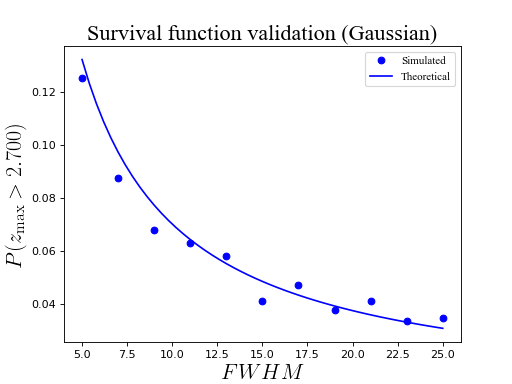Field maxima (Gaussian)¶
The basic procedure for RFT validations is outlined in Examples/Basic/Validating This section presents code details for validating the probability with which Gaussian field maxima survive particular thresholds, also as a function of smoothness.
See also ./rft1d/examples/val_max_0_gaussian_1d.py
As a function of threshold height¶
import numpy as np
from matplotlib import pyplot
import rft1d
#(0) Set parameters:
np.random.seed(123456789)
nResponses = 10000
nNodes = 101
FWHM = 10.0
#(1) Generate Gaussian 1D fields and extract maxima:
y = rft1d.randn1d(nResponses, nNodes, FWHM)
ymax = y.max(axis=1)
#(2) Survival functions for field maximum:
heights = np.linspace(2, 4, 21)
sf = np.array( [ (ymax>u).mean() for u in heights] )
sfE = rft1d.norm.sf(heights, nNodes, FWHM) #theoretical
sfN = rft1d.norm.sf0d(heights) #theoretical (0D)
#(3) Plot results:
pyplot.close('all')
ax = pyplot.axes()
ax.plot(heights, sf, 'bo', label='Simulated')
ax.plot(heights, sfE, 'b-', label='Theoretical')
ax.plot(heights, sfN, 'r-', label='Standard normal')
ax.set_xlabel('$u$', size=20)
ax.set_ylabel('$P (z_\mathrm{max} > u)$', size=20)
ax.legend()
ax.set_title('Survival function validation (Gaussian)', size=20)
pyplot.show()
(Source code, png, hires.png, pdf)

As a function of FWHM¶
import numpy as np
from matplotlib import pyplot
import rft1d
np.random.seed(123456789)
nResponses = 2000
nNodes = 101
u = 2.7
FWHM = np.linspace(5, 25, 11)
#(1) Generate Gaussian 1D fields and extract maxima:
SF = []
for w in FWHM:
y = rft1d.randn1d(nResponses, nNodes, w, pad=True)
ymax = y.max(axis=1)
SF.append( (ymax>u).mean() )
#(2) Expected survival functions:
FWHMi = np.linspace(min(FWHM), max(FWHM), 51)
sfE = [rft1d.norm.sf(u, nNodes, w) for w in FWHMi]
#(3) Plot results:
pyplot.close('all')
ax = pyplot.axes()
ax.plot(FWHM, SF, 'bo', label='Simulated')
ax.plot(FWHMi, sfE, 'b-', label='Theoretical')
ax.set_xlabel('$FWHM$', size=20)
ax.set_ylabel('$P (z_\mathrm{max} > %.3f)$'%u, size=20)
ax.legend()
ax.set_title('Survival function validation (Gaussian)', size=20)
pyplot.show()
(Source code, png, hires.png, pdf)

Note
Tighter convergence can be obtained by increasing the number of fields (nResponses in the example above).